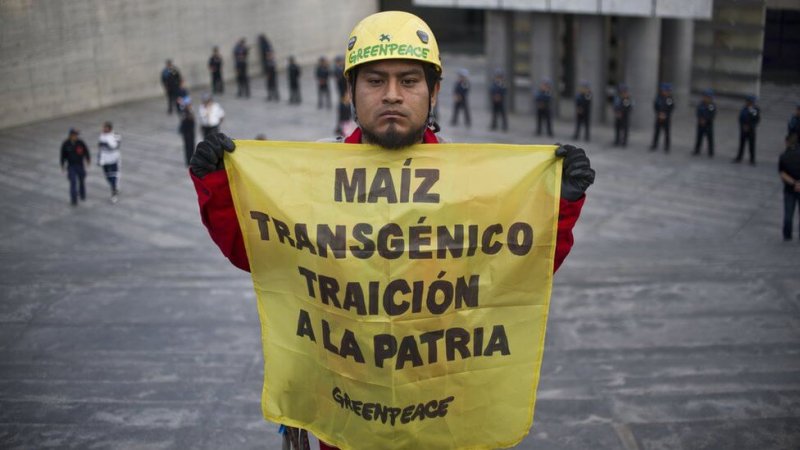Once the moratorium was extended, the president’s signature would have made it official. But weeks of political turmoil, during which three presidential contenders vied for executive power, have thrown the ban’s future into uncertainty. Congress kicked the former president out of office and installed his successor, who was forced to resign just a few days later. Peru appears to have selected a new chief executive to serve for at least the next several months, and the country’s choice has anti-GMO activists concerned.
The new head of State, Francisco Sagasti, is a dedicated academic, science advocate and former congressman who voted against the moratorium, arguing that such a measure should not be approved unless and until the Science, Innovation, and Technology Commission signs off on the proposal:
I regret that the moratorium on entry, production, and research on GMOs has been approved for such a long term —15 years—without input from experts who staff the Commission on Science, Innovation, and Technology. We will soon start a round of consultations to calmly and thoroughly analyze this complex issue.
Following this statement, the new environment minister announced that the Executive Branch is awaiting presidential approval to initiate a technical debate that will benefit from the input of government regulators and scientists, giving crop biotechnology advocates a brief opportunity to make their case and highlighting Peru’s complicated history with genetic engineering.
How we got here
The coalition of highly organized anti-GMO activists and organic food lobbyists behind the moratorium legislation did all they could to monopolize the debate, while simultaneously accusing the biotech industry of employing the same strategy. They claimed that seed companies were trying to force their way into the country, which of course wasn’t possible with a ban already in place. The activists also took to social media to attack GMOs and organize webinars to explain why the moratorium extension was necessary. Biotech experts were never invited to take part in the discussions, and events that presented both sides of the debate were few and far between.

As the moratorium legislation underwent exhaustive revision, many old myths about GM crops were utilized—yet again—to justify the ban. For example, the scandalous study conducted by Gilles-Éric Séralini was trotted out to associate “GMOs” with cancer, though experts have conclusively shown that the French geneticist’s findings are dubious. The activists also revived a classic argument, widely used around the world though new to Peru: “Marca Perú,” which means, “the country as a brand.”
Inspired by this rhetoric, politicians feared that the country’s brand could be harmed by the adoption of GM crops, since Peru has sold itself as an ancestral homeland to organic food produced from native seeds. While this argument generated enough support to extend the moratorium, it is little more than a marketing myth used to sell the image of Peru as a GM-free territory.
As it turns out, GM crops are anything but foreign to Peru. Many farmers in the country, perhaps unwittingly, have been cultivating insect-resistant biotech corn for years. The illegal practice has been universally condemned, but the experience of these growers nonetheless undermines the case made by ban proponents who claim biotechnology poses a threat to Peru.
GM Crops are not a novelty for Peruvian farmers
During the previous 10-year moratorium, commercializing and planting transgenic seeds was completely banned in Peru. That said, Peru was (and still is) an avid importer of commodities grown from genetically modified seeds, such as corn and soy. In 2019 alone, Peru spent $142.6 million on imported soy, 81% of which came from the United States, one of the top GM soy producers in the world. One of Peru’s most precious staple foods, maize, is likewise often grown from GM seeds in other countries. Last year, Peru imported almost four million tons of yellow corn, mainly from Argentina, one of the top GM crop producers in Latin America.
And this is where the story gets interesting. According to a report released this year by the Ministry of Environment (MINAM), some Peruvian farmers have for years repurposed this imported genetically modified grain as seed and planted it in their own fields.
The report noted that regulators in 2019 detected transgenes (GMOs) in 88.3% of the fields inspected and in 100% of collected grains, all samples coming from three maize varieties: “Pato” (duck) maize—which is a hybrid of yellow corn and alazan (a native race that has an intense red color)—and two other local races of white and purple corn. These findings aren’t unprecedented, either. Back in 2016 and 2018, authorities also found transgenes in the same region of the country (Piura), and inspections of other farming regions could reveal more illegal GM seed once the pandemic travel restrictions are lifted.
How did this happen?
Seed companies have never sold biotech products in Peru, even before the moratorium was enacted, mainly because the law has to be respected, but also because operating in a country with no GM crop regulations can invite problems no firm wants to deal with. However, the dearth of commercialized GM seed wasn’t much of a barrier for farmers.
Historically, Piura farmers have planted their own hybrid yellow maize, a common practice in the region because it’s far cheaper than buying certified hybrid seed. They recently began crossing their hybrid seed with alazan to obtain “Pato” (duck), a variety with a mix of both phenotypes. It’s used as animal feed (hence the name) and to make chicha de jora, a traditional beverage in the area.
At some point, farmers starting crossing this cultivated maize with imported GM yellow corn that was easily found in local markets, thus obtaining a “pato” maize with insect resistance. Farmers noticed the benefits of this new corn and decided to stick with it.

MINAM was able to better assess the situation after interviewing farmers in the region. Most notable were their reasons for choosing not to plant certified hybrid seed:
- The price of a bag of hybrid corn seeds is very high.
- The hybrid corn is more “plagued.” This means it is attacked by pests more frequently, which translates into a greater number of insecticide applications.
- Hybrid corn requires more irrigation (four to five applications of water per season). Water is a scarce resource at this time of year, so farmers can’t guarantee irrigation of their crops, putting their production and investment at risk.
- Hybrid corn is not good for preparing chicha; its color and taste are different.
- The commodity price of yellow corn is very low, “which discourages planting.”
Whether or not farmers knew they were planting and breeding genetically modified grain remains a mystery. It is also difficult to know precisely when their off-the-books breeding efforts began. But in a 2009 study, researchers from the National Agrarian University La Molina detected transgenes in grains from three different regions of Peru. As for the data coming from the most recent study in Piura, 89.9% of samples were positive for the Cry1A protein that most likely came from MON810, an old Monsanto insect-resistance event released back in the late 1990s that is no longer commercially available (new and improved varieties have since been released in other countries).
Even though this insect-resistance trait is many years old, farmers benefited from the technology. MINAM reported: “Although [Cry1A’s] effectiveness in controlling the pest is not the most optimal (due to the segregation of genes or the appearance of resistance), it is enough to reduce the use of pesticides by half or a third.” It is important to clarify that pest tolerance to the insecticidal protein was bound to evolve; Peruvian farmers have no knowledge of good farming practices designed to preserve the effectiveness of insect-resistant crops.
This evidence points to the possibility that growers have been illegally planting imported GM grain for over a decade, even before the official ban went into effect. But the eradication process is proving to be a real challenge. Farmers are not excited about giving up their “pato” maize for expensive hybrid seed that requires more water and twice the amount of pesticide. As a result, officials are looking forward to replacing the certified hybrid corn with different crops:
The reconversion of agriculture for another more profitable crop requires …. long-term work, taking into account the supply and demand of these products. Precisely, rice (produced in the big season) was the crop that displaced the hundreds of hectares of Pima cotton that were planted in the area, because the latter was no longer profitable. The farmer will always choose the crop that gives him the best income, especially if it is immediate since his agriculture is mainly subsistence.
A topic nobody wants to talk about
Regulators, biotech advocates, and anti-GMO groups know there are GM crops grown in Peruvian soil, but none of them wants to address the issue. Regulators do not want to reveal their actual position on such a politicized topic; the risk of a heavy media backlash is too great. Biotech advocates also avoid talking about this since they do not want the public to think they endorse illegal activity. On the other hand, anti-GMO groups simply won’t talk about farmers growing biotech crops to cut pesticide and water use because it challenges their narrative.
What’s next for biotech crops in Peru?
At this point, biotech advocates are struggling to keep their cause alive, wondering if GM crops will ever be approved by a country whose farmers clearly see the benefits of genetic engineering. Although the new administration’s comments have strengthened their resolve, the science community knows what’s at stake: rising crop losses they won’t be allowed to stop.
Peru’s biodiversity, which anti-biotech activist groups have sworn to protect, will also suffer. According to MINAM’s National Forest and Wildlife Service, smallholder farmers who cut down trees to cultivate agricultural areas smaller than five hectares are responsible for 78% of the country’s deforestation. The adoption of GM crops could curb land expansion by increasing crop yield and farmers’ incomes.
In a country where agricultural biotechnology research has been held back for a decade, scientists can only encourage the new administration to change course. If it won’t, consumers, farmers and the environment will suffer unnecessarily.
Sherly Montaguth is a biologist, content strategist and editor currently working as Communications Coordinator for the Andean Region of Agro-Bio. Follow her on Twitter @cherrymontaguth































